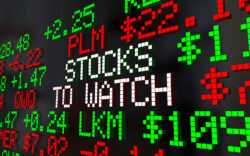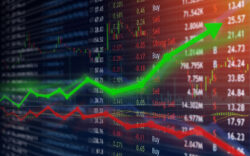In today’s issue:
- Be wary of the bond market
- Credit spreads are a key risk factor
- Investors ignore either at their peril
Yes, bonds are boring but that’s the point.
When it comes to investing, it’s often stocks and other high-risk assets that tend to grab the headlines.
But when bonds do make the headlines, as they have of late, investors should pay attention.
The bond market has a long history of contributing to crashes or at least corrections in the stock market.
But why? Let me explain…
It all comes down to simple maths – or physics, as I like to call it.
Now, I know the mere mention of maths or physics might tempt you to close this email and move on. But let me assure you, doing so could be a missed opportunity (even if some might choose to ignore it).
Because what I’ll share with you below is one of the core principles of investing. Understanding it is essential to building long-term success in your investment journey.
So, sit tight, and I’ll explain why this is so important.
As head of European Macro Strategy at Lehman Brothers in the early 2000s, each year I would give a lecture to the class of incoming analysts and associates.
This was titled “The Physics of Financial Markets”. Its purpose was to provide the new recruits with a framework for understanding the relationships between the bond, credit and equity markets.
The first section was “The Universal Constant” and it was about interest rates. No matter what the asset, its valuation is always a function, in whole or part, of interest rates.
This is because all financial assets are claims on future cash flows. You need to discount those cash flows at some rate in order to have a current price, or net present value (NPV) in financial speak.
As the interest rate increases, the present value of future cash flows declines. That’s just financial maths.
The farther out in the future the cash flows are, the more sensitive their present value to interest rates. In financial maths this relationship is called “duration”.
It applies both to cash flows that are certain – such as those from government bonds – or uncertain, such as those from equities or other risky assets.
However, the relative sensitivity of assets to interest rates also depends on how risky they are. That leads us to the second section of the lecture, “The Risk Spectrum”.
Sometimes, stocks do what they shouldn’t
It explained how, the riskier the asset, the less sensitive its price was to changes in interest rates.
Now, you might think this means the stock market can keep right on rising even as financial maths says it shouldn’t. You’re right. Stocks have a habit of rising, sometimes into a bubble, alongside rising interest rates. This was the case leading into the global financial crisis of 2008, for example.
But at some point, the party comes to an end. And what point is that? The point at which companies start feeling the pinch. When they have to pay a rising credit premium to borrow.
When you go to the bank for a loan you don’t pay the base rate set by the Bank of England. That’s only for the banks. You pay a premium.
So do companies. And when that premium rises it slows down or stops the flow of credit from banks and corporations. Part three of my lecture was titled “The Transmission Mechanism” and this is what it was about.
Most companies carry some level of debt on their balance sheets. For some, this debt is significant, meaning their share prices can be heavily influenced by fluctuations in interest rates and changes in corporate credit spreads.
When interest rates rise AND corporate credit spreads widen out, indebted companies get hit by a double whammy. This can have a huge impact on their valuations. Again, it comes down to financial maths. Whatever expectations investors might have for future revenue growth and profitability will need to be adjusted lower based on the new reality of higher debt servicing costs.
It can get worse. Imagine that, beyond rising interest rates and widening credit spreads increasing borrowing costs, the investors in some companies are also using leverage themselves.
Most hedge funds take on some debt – leverage – to try and generate higher returns. When their cost of debt servicing rises alongside that of the companies in which they invest, it adds up to a triple whammy.
And it can get even worse.
Section four of the lecture was “The Physics of Financial Crises”. That’s where I explained how the banks that lend to those hedge funds are themselves leveraged.
If interest rates and/or credit spreads rise sufficiently, their risk models will tell them to reduce their credit lines to hedge funds to limit their potential exposure to losses in the event one or more get into trouble.
As banks reduce credit lines, hedge funds become forced sellers. It no longer matters what they think about a company’s prospects. They’ll have to sell the stock regardless.
When some of the debt and leverage behind a rising stock market is suddenly removed, watch out below.
What begins with interest rates ends with forced selling
That’s when you potentially get a stock market crash. But it all begins with interest rates and credit spreads and becomes a reality when the forced selling begins.
By that time, if you’re still chasing returns, it’s too late to act. You’ll take a hit.
Hence when the bond market speaks, stock market investors should listen. If credit spreads begin to widen out, you should take action to get more defensive.
Taking on any additional risk from that point forward is playing with fire. And that’s why it’s so important to keep your eyes on the chart below.
The most important chart to watch right now: US bond yields (left scale) and credit spreads (right scale)

Like it or not, what happens in the US bond, credit and stock markets will largely determine what happens here in the UK.
As US bond yields have risen over the past few years, credit spreads haven’t widened out but in fact have declined to historically low levels: as low as leading into the global financial crisis of 2008. That has supported the stock market, so far at least.
But as seen in the chart, just recently that may have begun to change. If credit spreads widen out from here, those who continue to chase the stock market may eventually receive a painful lesson in “The Physics of Financial Markets”.
So how can you apply all this in a simple way? Tomorrow, we’ll explain exactly how.
Until next time,

John Butler
Investment Director, Fortune & Freedom




